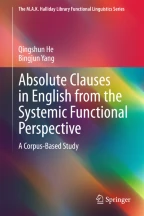
As a special syntactical structure in English, absolute clauses are traditionally believed to be non-finite clauses with explicit subject, implying temporal, conditional, causal, concessive, or circumstantial relations. Many scholars argue that, apart from a few stereotyped phrases, absolute clauses are formal and infrequent in English and are gradually decreasing in number, and that the subjects of absolute clauses are zero case nouns or nominative pronouns. The related literature shows that absolute clauses are given sufficient consideration by traditional grammarians on the one hand, and on the other hand, many deficiencies occur to the descriptions.
Systemic functional linguistics (SFL) is meaning-centered, which considers language as a meaning system, and focuses on the realization of meaning at the lexico-grammatical stratum. Focusing on language in use, SFL supports and is supported by corpus-based approaches. However, absolute clauses have not been touched by SFL researchers so far. No study on absolute clauses in SFL can be found, except that in the discussion of logico-semantic relations realized by non-finite clauses, it is pointed out that non-finite clauses may have their own subjects.
This research is corpus-based and the data were collected from the following corpora: the Brown Family Corpora (Brown, Frown, Crown, LOB, FLOB and CLOB), BNC (British National Corpus), COCA (Corpus of Contemporary American English), and COHA (Corpus of Historical American English). Applying corpus retrieval tools and analysis softwares such as TreeTagger 2.0, AntConc 3.2.4w and UAM CorpusTool 2.8.12, we extracted 60,187 absolute clauses in total from the Brown Family Corpora, BNC, and COHA, including 12,298 of expansion and 47,889 of projection. With the data collected from these corpora, we investigated into the function types of absolute clauses and their diachronic, stylistic, and case distributions from the SFL perspective.
In SFL, the relationships between clauses in a clause complex include two dimensions: interdependency and logico-semantic relation. The former consists of two relations, i.e., parataxis and hypotaxis, and the latter, expansion and projection. The three function types of absolute clauses, i.e., appositives, attendant circumstances, and clausal adjuncts in traditional grammar correspond to the three hypotactic expansions, i.e., elaboration, extension, and enhancement, in SFL. In interdependent relations, absolute clauses are non-finite clauses. They can realize hypotactic but not paratactic relations. In logico-semantic relations, since non-finite clauses can realize both expansion and projection, absolute clauses also have the potential to realize projection. According to double transitivity analyses, the hypotactic relations in clause complexes can also be embedding. Absolute clauses realizing expansion also realize circumstances, and those realizing projection realize participants. The projected clauses are the syntactic complement of the projecting verbs. Since the projected complement clauses can form into absolute clauses, the subject clauses can also form into absolute clauses.
In addition to hypotactic clauses in clause complexes, independently used clauses can also form into absolute clauses, elaborating, extending, or enhancing the preceding or following clauses. These relations, however, are textually cohesive. Independently used clauses tend to be paratactic, and since absolute clauses can be used independently, they also have the potential to realize paratactic relations. There are two factors determining the formation of paratactic relations: the primary clauses and the secondary clauses cannot be transposed; the secondary clauses can be used independently. Some absolute clauses fulfilling the two requirements can realize paratactic relations. Therefore, absolute clauses have the same meaning potential as finite clauses. According to the identification criteria of absolute clauses we proposed, absolute clauses can realize both hypotaxis and parataxis, both expansion (i.e., elaboration, extension, and enhancement) and projection (i.e., fact and act). Four function types of absolute clauses can thus be identified: absolute adjunct clauses (including absolute clauses of hypotactic extension and absolute clauses of hypotactic enhancement), absolute appositive clauses (absolute clauses of elaboration), absolute complement clauses (absolute clauses of projection), and absolute subject clauses (absolute clauses of embedding).
Corpus-based analyses of these re-categorized types of absolute clauses from the SFL perspective show that, contrary to many existing viewpoints, absolute clauses display a number of characteristics we have never considered. In this respect, SFL is illuminating as a theory to the study of absolute clauses.
This is a preview of subscription content, log in via an institution to check access.